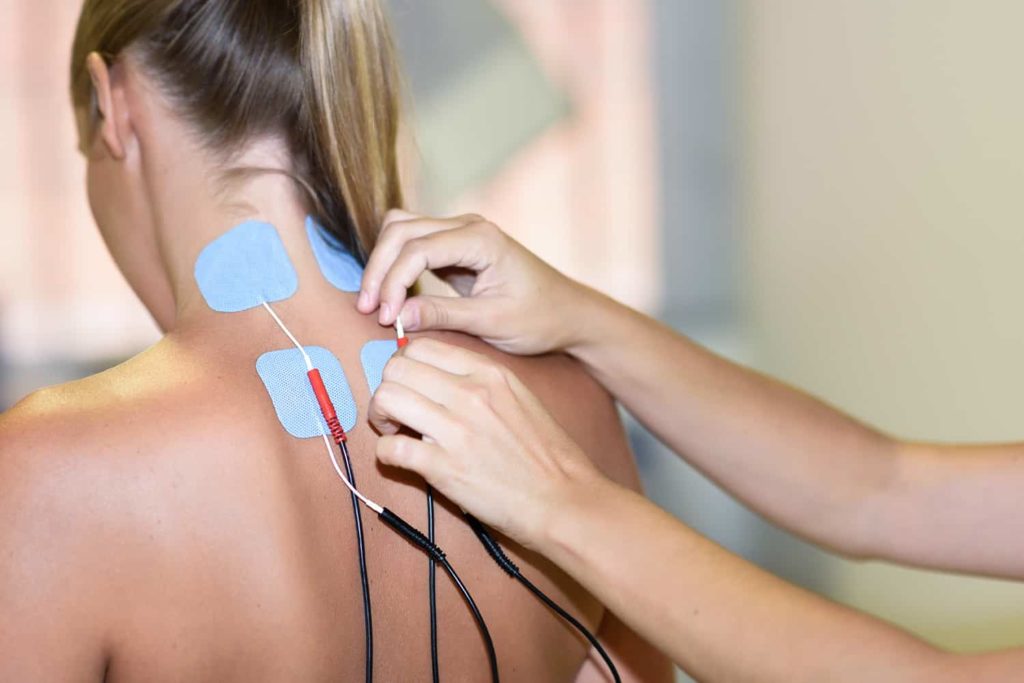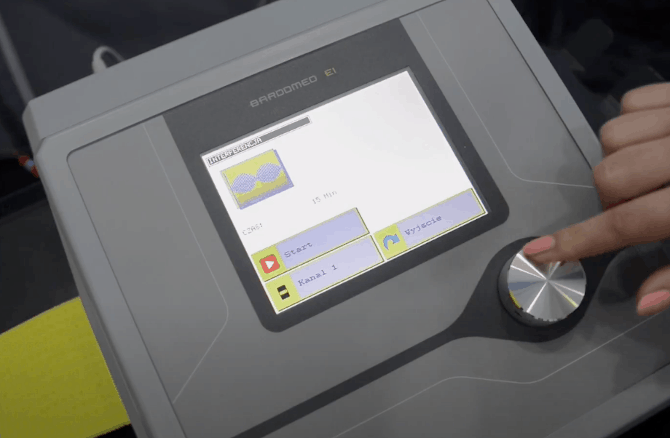Interference currents are one of the valuable rehabilitation methods. The indications for their use are very broad and painless methods of treatment. Who can use them? What are the contraindications? We will write about this below, and finally, we recommend a device that allows you to perform interference therapy – devices that we have tested ourselves and consider worthy of attention.
Interference currents (in other words: Nemec currents) is a therapy that involves the intersection of two independent circuits with currents at different frequencies. The electrodes are arranged in a square, so that interference occurs in the damaged area, creating an electrical therapeutic stimulus at that location. For this, mid and low frequencies are used. The main advantage of interference currents is the ability to penetrate into deeper tissues compared to other types of electrotherapy.

Interference currents – action
The most important results of use for Interference rehabilitation are pain relief, muscle stimulation, improved blood flow, tissue nutrition. However, different frequencies are responsible for different effects. What does this division look like?
- 0-10 Hz – causes muscle spasms;
- 25-50 Hz – improves blood circulation, stimulates muscle work;
- 50-100 Hz – nourishes tissues, stimulates their metabolism, pain relievers;
- 90-100 Hz – reduces pain and tension in the nervous system;
- 0-100 Hz – pain relievers and nourishes, improves blood circulation and stimulates muscles.
Depending on the type of disease, different frequencies are also used: Acute conditions are usually treated with a frequency of 100 or 200 Hz, and chronic ones – with a frequency of 100 Hz. Treatments last from 5 to 30 minutes and are usually repeated every day and at least twice a week. Usually one therapy consists of several or several procedures and depends on the condition of the disease (acute, chronic).

There are two methods of conducting interference therapy – static, when the electrodes are attached in one place, and dynamic, during which the physiotherapist changes the position of the electrodes during the procedure.
Interference currents – readings
When are interference currents used? The effect of this therapy is especially recommended for diseases such as:
- muscle atrophy or weakness
- cardiovascular disorders,
- neuralgia, neuritis, pressure syndromes,
- back pain,
- degenerative diseases of the spine,
- degenerative joint diseases, rheumatism,
- injury and inflammation of a muscle, joint or tendon
- inflammation in the shoulder area
- problems with bone growth,
- migraines,
- urinary incontinence.
Contraindications for treatment with interference
Despite the many advantages and universal application of electrotherapy, unfortunately, there are quite a few contraindications to its use. In this respect, rehabilitation with the help of interference current is practically no different from other methods of electrotherapy. The use of interference currents is excluded by the following factors or diseases:
- an implanted pacemaker or other electrical device
- metal implanted components,
- skin damage or inflammation at the site of therapy, dermatological diseases,
- pregnancy,
- cancer,
- multiple sclerosis,
- Parkinson’s disease
- cardiovascular problems (associated with blood clots, embolism, varicose veins, atherosclerosis),
- acute infections, fever,
- sensory disorders
- difficult contact with the patient, mental disorders.
Interference currents – devices for physiotherapists
Our offer includes several devices that allow for rehabilitation using interference. The BARDOMED E1 electrotherapy device produces all types of low and medium frequency waves, making it a versatile instrument for many electrotherapy procedures. Independent channels allow you to support two patients at the same time. Similar capabilities are also provided by the Multitronic MT-3 device.
If we are interested in more general equipment, it is worth checking out the BARDOMED EU1 electrotherapy and ultrasound device and other models of the Multitronic series, which also offer laser therapy, ultrasound and magnetotherapy. They are located in the COMBI combination therapy devices section.
A more compact solution is the portable devices T-ONE REHAB and T-ONE MEDI PRO, which are used to carry out the most popular electrotherapy procedures outside the office – at the patient’s home. or where appropriate.
Using interference currents, physiotherapy over time also gained additional opportunities for action – on the basis of this, many new methods of rehabilitation were created. It is worth using all of them when choosing therapy for the patient’s needs and preferences. In the case of interference currents, the indications offer great opportunities – they are good to remember, especially when we are dealing with diseases of deep tissues, because they have a much shorter list of effective treatments.
